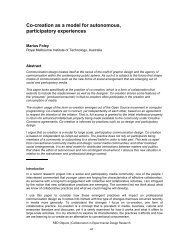Ceramic Tableware Recycling by Green Life 21 Project - Red Objects
Ceramic Tableware Recycling by Green Life 21 Project - Red Objects
Ceramic Tableware Recycling by Green Life 21 Project - Red Objects
You also want an ePaper? Increase the reach of your titles
YUMPU automatically turns print PDFs into web optimized ePapers that Google loves.
Table 2 CO2 emission of recycled and conventional tableware in processes [kgC/t]<br />
Recycled tableware Conventional tableware<br />
Recovery 2.4 Mining 0.5<br />
Body preparation Crushing 4.3 Refining and crushing 8.3<br />
Preparation 10.9 Preparation 10.9<br />
19.3* 1 19.7*<br />
<strong>Tableware</strong> manufacturing 427.4 427.4<br />
Total CO2 emission 446.7 447.1<br />
*1 (2.4+4.3+19.9)×20%+(0.5+8.3+10.9)×80%=19.3<br />
*2 (0.5+8.3+10.9)×100%=19.7<br />
2.3 Reinforced Porcelain <strong>Tableware</strong> <strong>Recycling</strong><br />
In addition to the aforementioned recycling of general porcelain tableware, there is the recycling of<br />
the reinforced porcelain tableware that is used in school food services. The recycling method is<br />
technically the same as general porcelain tableware. However, reinforced tableware is<br />
manufactured <strong>by</strong> incorporating approximately 30% of more expensive aluminum in order to<br />
increase product strength. In the recycling of reinforced porcelain tableware, used reinforced<br />
porcelain tableware is collected to use the aluminum that it contains in order to reduce the volume<br />
of aluminum consumption. The advantage is to offset purchase costs, transport costs and crushing<br />
costs <strong>by</strong> collecting used reinforced porcelain tableware as a valuable resource to avoid the cost of<br />
using new aluminum. It can also reduce the CO2 emission volume <strong>by</strong> approximately 3% <strong>by</strong> reducing<br />
the amount of high LAC aluminum consumption (in the case of combining recycled materials at<br />
20%) (Takahashi 2009, p. 37).<br />
3. System for Manufacturing Recycled <strong>Tableware</strong>—Re-shokki<br />
In order to put these recycling technologies to practical use, it is necessary for the suppliers to<br />
establish a system for manufacturing recycled tableware. Since the tableware manufacturing<br />
processes are remarkably divided into small processes for each company in the Mino ware<br />
production area, it is difficult for a single manufacturer to complete the entire recycling process.<br />
Therefore, companies engaged in different business categories—such as the collection and<br />
transport of used tableware, crushing, clay preparation, pottery manufacturing, and wholesaling—<br />
must cooperate and organize a system to create a recycling loop. Moreover, in order to create a<br />
closed loop “from tableware to tableware,” measures must be taken for surplus tableware that<br />
cannot be recycled. Cooperation is also required with companies involved in building materials,<br />
which use the surplus tableware effectively. The GL<strong>21</strong> has created this type of cooperative system<br />
between suppliers and functions as a system for manufacturing recycled tableware. The GL<strong>21</strong> has<br />
also promoted cooperation with multiple governmental agencies and university researchers and has<br />
obtained support for recycling technology, environmental designs and marketing. “Re-shokki” is the<br />
name given to the tableware manufactured under the system for manufacturing recycled tableware<br />
shown in Figure 2 (GL<strong>21</strong> System).<br />
RED <strong>Objects</strong>⏐⏐Collaboration in Experimental Design Research<br />
76




